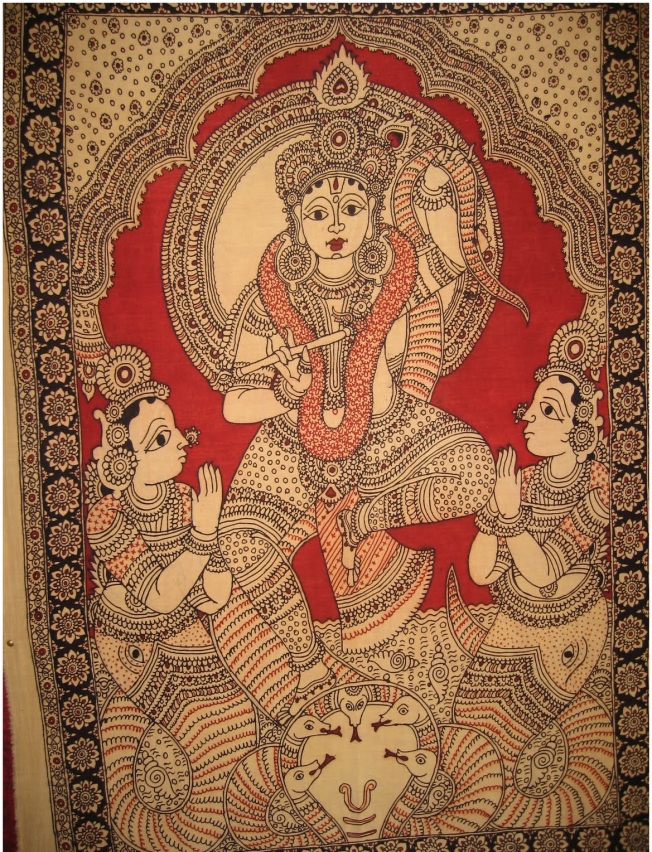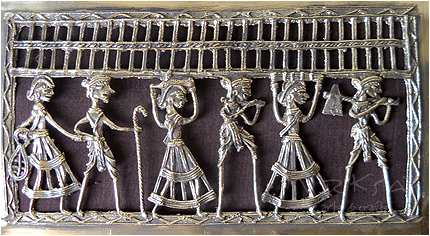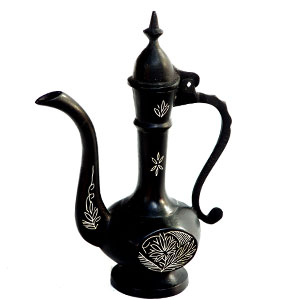
The Cloth of Goddess Mother, or Mata ni Pachedi, as the term is popularly called, is a very popular narrative scroll from Gujarat. These were made by the Vaghris, the wandering caste. The Vaghris were once a wandering caste, some of whom have now settled in Ahemdabad, the great industrialized city of Gujarat.
They make their living outside their houses, in a little lane by the Central Post Office, block printing and painting shrine cloths, which are known as ‘mata-ni-pachedi’ or ‘mata-no-chandarvo’.

Traditionally, the shrine cloths are made for ritual use by members of castes such as sweepers, leather workers, farm laborers, or by the Vaghris themselves. The shrine cloths always have as a central feature an image of the ‘mata’– the mother goddess in her fearsome aspect- sitting on her throne, or mounted on an animal, brandishing in her hands the weapons needed to kill demons. In the background, is an architectural rendering of a temple. In the centre is placed the image of the Mother Goddess and her associates. Around the goddess are depicted the scenes from the mythology of that deity, as also her followers and worshippers. It is usually rectangular in shape and is divided into seven to nine partitions, very much like a Jain miniature painting.
When any of the mata’s devotees suffers illness or misfortune, he goes to the mata’s shrine and vows that he will make a sacrifice to her if she will relieve him of his trouble. If his wish is granted, he pays for the shrine to be cleaned and decorated, and an enclosure made up of ‘pached’(rectangular shrine cloths) is erected around the shrine, with the chandarvo, the great square shrine canopy, draped above it.
A ceremony of chants and a trance-inducing dance is conducted by a priest-shaman, known as a ‘bhuvo’. This is followed by the ritual sacrifice: the cooking and eating of a young goat. There is always a depiction of a bhuvo-priest, leading a sacrificial animal to the mata, on a pachedi, or chandarvo.

Before the decoration of these cloths can begin, the material must first be freed of starch and then after washing and drying in the sun, soaking it again, this time in a mixture of salt and cow dung and then boiling. Next, it is immersed in water containing caustic soda and castor oil, and based solution of myrobalan and castor oil and dried, it is ready for printing.
 The motifs of the Mata-ni-Pachedi are then printed on with large wooden blocks, using a dye made out of rusted iron which has been soaked for a week in sugar solution thickened with a flour of tamarind seeds. This reacts with the myrobalan mordant to produce black. Most of the spaces between the black printed figures are painted with alum and starch using a cheed tooth-stick. The shrine cloths are then passed to dyers, who dye them in vats of alizarin, which reacts with alum to form a deep red.
The motifs of the Mata-ni-Pachedi are then printed on with large wooden blocks, using a dye made out of rusted iron which has been soaked for a week in sugar solution thickened with a flour of tamarind seeds. This reacts with the myrobalan mordant to produce black. Most of the spaces between the black printed figures are painted with alum and starch using a cheed tooth-stick. The shrine cloths are then passed to dyers, who dye them in vats of alizarin, which reacts with alum to form a deep red. 
The art work is framed with a bold border, and is divided into a line of single color and a band of decorative linear patterns. The colors of the pachedi are black, blood red and white. The surface of the material also acts as a color.
The pachedi usually gets sold around the time of Navaratra, i.e. April and September. Today it has been reinvented as decorative wall pieces.





















 Draw preliminary lines with charcoal, usually made of burnt tamarind twigs. Dip the kalam in iron black solution. The woollen ball attached to the reed absorbs the dye. The artist then drags the kalam in upright position on the cloth, slightly squeezing the woolen ball. The dye on contact with the myrobalan treated cloth turns in to black. (Reaction of Fe. Acetate on Tannin)
Draw preliminary lines with charcoal, usually made of burnt tamarind twigs. Dip the kalam in iron black solution. The woollen ball attached to the reed absorbs the dye. The artist then drags the kalam in upright position on the cloth, slightly squeezing the woolen ball. The dye on contact with the myrobalan treated cloth turns in to black. (Reaction of Fe. Acetate on Tannin)


 The cloth is soaked in sheep’s dung solution and squeezed a little and kept wet over night.
The cloth is soaked in sheep’s dung solution and squeezed a little and kept wet over night.



















































